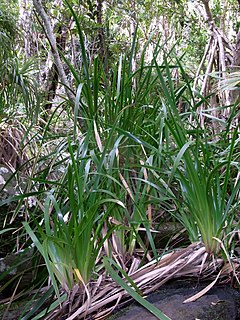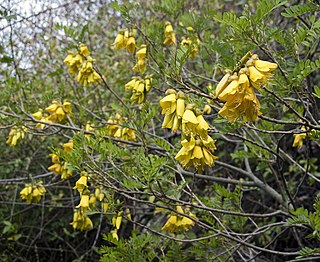
Pittosporum revolutum, the rough-fruited pittosporum, yellow pittosporum, Brisbane laurel or wild yellow jasmine, is a shrub that is endemic to Australia. The species grows up to 3 metres in height and has leaves that are 5 to 15 cm long and 1.5 to 6 cm wide. The fragrant, yellow flowers appear in terminal clusters in spring. It occurs in habitats ranging from rainforest to dry sclerophyll forests in Queensland, New South Wales and Victoria.

Passiflora herbertiana, or native passionfruit, is a widespread climbing twiner native to moist forests on the coast and ranges of eastern Australia. The subspecies P. h. insulae-howei is endemic to Lord Howe Island in the Tasman Sea.

Pittosporum tobira is a species of sweet-smelling flowering plant in the pittosporum family Pittosporaceae known by several common names, including Australian laurel, Japanese pittosporum, mock orange and Japanese cheesewood. It is native to Japan, China, Taiwan, and Korea, but it is used throughout the world as an ornamental plant in landscaping and as cut foliage.

Dietes robinsoniana, the Lord Howe wedding lily, is found naturally only on Lord Howe Island. It grows on cliff faces, often in exposed situations. Found also on forest margins and the tops of Mount Gower and Mount Lidgbird and behind the beaches on Lord Howe Island. It is one of the world's most intriguing and remarkable biogeographic disjunctions, with its nearest phylogenetic relatives occurring in Africa.

Syzygium fullagarii, commonly known as the scalybark, is a relatively large tree in the Myrtle family. It is found only on Lord Howe Island. It grows to 20 metres tall, up to an altitude of 400 metres above sea level in sheltered areas, often in rainforest. The bark is reddish brown, usually flaking to the touch. The base of the tree is often heavily buttressed. Known for many years as Cleistocalyx fullagarii, however, in recent times it has been placed in the large genus Syzygium.

Alyxia squamulosa, commonly known as alyxia vine, is a species of shrub in the family Apocynaceae. It is endemic to Australia’s subtropical Lord Howe Island in the Tasman Sea. The specific epithet derives from the many bracteoles, or ‘scales’ that subtend the flowers. The plant previously known as Alyxia lindii is considered a taxonomic synonym of A. squamulosa, being reassigned in 2002.
Olearia mooneyi, commonly known as pumpkin bush, is a large shrub or small tree in the daisy family, Asteraceae. The specific epithet honours Thomas Mooney (1842–1873), an early settler of Lord Howe Island who was interested in its plants.

Leptopteris moorei is a fern in the family Osmundaceae. The specific epithet honours Charles Moore, Director of the Royal Botanic Gardens in Sydney from 1849 to 1896, who collected plants on Lord Howe Island in 1869.
Lepidium howei-insulae , commonly known as mustard & cress, is a flowering plant in the mustard and cabbage family. The specific epithet alludes to Lord Howe Island, where it is found.
Gahnia howeana is a flowering plant in the sedge family. The specific epithet refers to Lord Howe Island, where it is found. It was formerly lumped with Gahnia xanthocarpa, which is now considered to be endemic to New Zealand.

Machaerina insularis is a flowering plant in the sedge family. The specific epithet is the Latin insularis, alluding to its island home.

Uncinia debilior is a flowering plant in the sedge family. The specific epithet derives from the Latin debilis, with reference to the species having weaker culms than Uncinia compacta.

Dracophyllum fitzgeraldii, commonly known as the Fitzgeraldii tree or Fitzgerald tree, is a flowering plant in the family Ericaceae. It is endemic to Lord Howe Island, though its closest relatives are species native to northern Queensland and to New Caledonia.
Corokia carpodetoides, simply known locally as corokia, is a flowering plant in the Argophyllaceae family. The specific epithet derives from a resemblance to the genus Carpodetus, with the addition of the Latin suffix -oides (“resembling”).

Sophora howinsula, commonly known as lignum vitae or Lord Howe kowhai, is a flowering plant in the legume family. The specific epithet refers to the island to which the species is endemic.
Luzula longiflora is a flowering plant in the rush family. The specific epithet refers to the relatively long floral perianth.

Cryptocarya gregsonii, commonly known as native blackbutt, black plum or laurel, is a flowering plant in the laurel family. The specific epithet honours Jesse Gregson of Newcastle, New South Wales, a botanical friend of Maiden.
Geniostoma huttonii is a flowering plant in the Loganiaceae family. The specific epithet honours Ian Hutton who discovered the species in the course of his explorations of the Island.
Geniostoma petiolosum, commonly known as boar tree, is a flowering plant in the Loganiaceae family. The specific epithet refers to the relatively long and narrow petioles.
Rapanea mccomishii is a flowering plant in the family Primulaceae. The specific epithet honours James Doran McComish (1881–1948), who made several visits to, and collected extensively on, Lord Howe Island in the 1930s.












